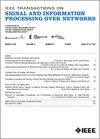Detection and Recovery of Hidden Submatrices
IF 3
3区 计算机科学
Q2 ENGINEERING, ELECTRICAL & ELECTRONIC
IEEE Transactions on Signal and Information Processing over Networks
Pub Date : 2024-01-10
DOI:10.1109/TSIPN.2024.3352264
引用次数: 0
Abstract
In this paper, we study the problems of detection and recovery of hidden submatrices with elevated means inside a large Gaussian random matrix. We consider two different structures for the planted submatrices. In the first model, the planted matrices are disjoint, and their row and column indices can be arbitrary. Inspired by scientific applications, the second model restricts the row and column indices to be consecutive. In the detection problem, under the null hypothesis, the observed matrix is a realization of independent and identically distributed standard normal entries. Under the alternative, there exists a set of hidden submatrices with elevated means inside the same standard normal matrix. Recovery refers to the task of locating the hidden submatrices. For both problems, and for both models, we characterize the statistical and computational barriers by deriving information-theoretic lower bounds, designing and analyzing algorithms matching those bounds, and proving computational lower bounds based on the low-degree polynomials conjecture. In particular, we show that the space of the model parameters (i.e., number of planted submatrices, their dimensions, and elevated mean) can be partitioned into three regions: the隐藏子矩阵的检测与恢复
在本文中,我们研究了大型高斯随机矩阵中具有提升手段的隐藏子矩阵的检测和恢复问题。我们考虑了两种不同的种植子矩阵结构。在第一个模型中,种植矩阵是不相交的,其行和列的索引可以是任意的。受科学应用的启发,第二种模型限制行和列的索引必须是连续的。在检测问题中,在零假设下,观测矩阵是独立且同分布的标准正态条目的实现。在备择假设下,同一标准正态矩阵内部存在一组均值升高的隐藏子矩阵。恢复是指找到隐藏子矩阵的任务。对于这两个问题和两种模型,我们通过推导信息论下限、设计和分析与这些下限相匹配的算法,以及证明基于低度多项式猜想的计算下限,来描述统计和计算障碍的特征。我们特别指出,模型参数的空间(即种植子矩阵的数量、维数和升高的平均值)可以划分为三个区域:不可能区域,所有算法都会失败;困难区域,虽然检测或恢复在统计上是可能的,但我们给出了一些证据,证明不存在多项式时间算法;最后是容易区域,存在多项式时间算法。
本文章由计算机程序翻译,如有差异,请以英文原文为准。
求助全文
约1分钟内获得全文
求助全文
来源期刊

IEEE Transactions on Signal and Information Processing over Networks
Computer Science-Computer Networks and Communications
CiteScore
5.80
自引率
12.50%
发文量
56
期刊介绍:
The IEEE Transactions on Signal and Information Processing over Networks publishes high-quality papers that extend the classical notions of processing of signals defined over vector spaces (e.g. time and space) to processing of signals and information (data) defined over networks, potentially dynamically varying. In signal processing over networks, the topology of the network may define structural relationships in the data, or may constrain processing of the data. Topics include distributed algorithms for filtering, detection, estimation, adaptation and learning, model selection, data fusion, and diffusion or evolution of information over such networks, and applications of distributed signal processing.
 求助内容:
求助内容: 应助结果提醒方式:
应助结果提醒方式:


